Search areas for offshore wind energy: scoping study
Scoping study about identifying areas of search to potentially be developed into draft plan options for offshore wind energy in Scottish waters.
3. Methodology
A single mapped output identifying the strongest areas of constraint and opportunity within Scottish waters serves as a guide for planning the most appropriate areas of search for the development of offshore wind. This multi-criteria spatial output helps select broad areas that minimise interaction with the existing uses of the sea. GIS techniques provide a method to generate such an output and to manipulate the relative influence of its component layers.
The layers of relevant spatial information were collected and standardised to:
- Coordinate reference system ( WGS 84): this ensures all the layers are spatially compatible
- Geographical extent (Scottish waters by using the Scottish renewables EEZ): this makes all layers overlap within the same spatial extent
- Grid square (pixel) size: all layers, if not already, were converted to raster and the grid square size selected for all was the same
- Number of range classes: for ease of comparability each layer was reclassified into a maximum of three classes: high level of constraint, medium level of constraint or minimal level of constraint. This was done for quantitative layers, for example depth in the bathymetry layer and where possible for categorical layers, for example type of seabed substrate. Some layers only present one class as there is no differentiation in their values, for example the radar interference layer or the helicopter routes
3.1 Reclassification of layers to three classes
The classification of the layers into a maximum of three classes serves to make these different sources of spatial information standardised to the same scale so they are comparable in value. It is important to select appropriate cut-off value points when selecting three classes as the resulting divisions have to remain representative of each layer's data values. The classification into three classes was done on an individual layer basis as the process cannot be applied in the same manner to all layers.
For layers like bathymetry the classification process is straightforward as they can be divided into known accessibility depths. For quantitative layers that are composed of a range of numerical values the statistical functions of the ArcGIS GIS system were applied to find the most suitable values to use for class separation. The resulting outputs were checked visually to ensure that all parts of the value distribution were being represented. Section 8.2 describes the layers used and the method applied for reclassification.
3.2 Overlay procedure
Once standardised into a maximum of three classes the layers are added together using a GIS overlaying tool that sums each layer's grid square values. Since all the layers have been standardised to be drawn in exactly the same location the grid squares line up and can be added together. The relative weighting between layers is included at this time by the GIS operator.
This cumulative value per grid square is what results in the overall weight layer that can then be interpreted as showing the variation in constraint over the study area.
This multi-criteria analysis output can then be used as a guiding template to select broad areas that fall within an acceptable level of constraint. These broad areas can then be refined into discrete options that minimise constraint and maximise opportunity. Section 6 describes the process undertaken to refine these broad areas of higher opportunity into smaller AoS from which the final Plan Options will be produced. The level of constraint will affect the ease of licensing and consenting of any one option. An area that displays low constraint translates into a site that is likely to go through the consenting and licensing phase with fewer objections. The opposite is true for a heavily constrained site.
The content of the spatial layers of information was separated into four data type categories:
- Environmental aspects: nature designated sites, species density, seabird collision vulnerability
- Industrial activities and features: helicopter transit lines, shipping density, fishing intensity
- Socio-cultural content: sea-based leisure activities
- Technical aspects: distance from substations and cable landings, depth, wind resource
These four data categories have been combined together to form an overall expression of the relative degree of constraint and opportunity for new offshore wind energy developments. The level of influence of each layer on the final output was guided by the relative weightings between layers used in Davies and Watret (2011).
3.3 Relative influence of layers
In order to create a reliable multi-criteria output the relative weights between layers need to be set so that those that are more relevant and important to the outcome have the greatest influence and help identify the higher constraint. Davies and Watret, (2011) used a relative set of weightings and scores that has been reviewed and revised for this study. Weightings were applied to each layer as a whole. In this study the maximum score that any layer's class can reach is 3 (high), the minimum is 1 (low).The maximum weighting of any layer is 10. The layer overlaying tool multiplies the layer weighting by each of the classification scores to generate the overall constraint output.
The weighting and scoring value range is different compared to the 2011 scoping study but the relative difference in overall influence between layers has been maintained. This ensures that the considerations that were appropriate for the 2011 offshore wind scoping study are included into the update. Table 1 shows the layers that have been used in the scoping update of 2018, the equivalent layer that was used in (Davies and Watret, 2011) has been included as a comparison.
Table 2: GIS layers of spatial information used in the updated scoping study and the scoping study (Davies and Watret, 2011)
| Data Theme | Layers used in Scoping Study for Offshore Wind Farm Development in Scottish Waters 2011 |
Weightings applied | Maximum score | Potential maximum influence |
|---|---|---|---|---|
| Environmental | Cetacean density (JNCC) Atlas of Cetacean distribution in north-west European waters (2003) Reid, J.B., Evans, P.G.H., & Northridge, S.P. | 900 | 164 | 147600 |
| Environmental | Nature protection designated areas (MPA, SAC, SPA, SSSI, RAMSAR) | 1000 | 100 | 100000 |
| Environmental | Seabird distribution during breeding season (ESAS density surfaces, 2010) | 1000 | 182 | 182000 |
| Environmental | Seabird distribution during winter season. Data used from ESAS (2010). | 1000 | 182 | 182000 |
| Environmental | Nursery areas for commercial fish species Coull et al. (1998) | 400 | 73 | 29200 |
| Environmental | Spawning areas for commercial fish species, Coull et al. (1998) | 400 | 73 | 29200 |
| Environmental | not included | - | - | - |
| Environmental | not included | - | - | - |
| Industrial | AIS shipping Anatec (2010) | 1000 | 182 | 182000 |
| Industrial | Static and mobile fishing ground classified by distance banding from the shore | 1000/600 | 182/109 | 182000/65400 |
| Industrial | Helicopter routes (National air traffic services, NATS) | 600 | 100 | 60000 |
| Industrial | Military exercise (PEXA) from GIS provider and classified into risk levels after consultation with MOD | 1000 | 180 | 180000 |
| Industrial | Radar interference at 140 m (NATS) | 600 | 100 | 60000 |
| Socio-economic | RYA routes and sailing areas (RYA 2010) | 300 | 30 | 9000 |
| Technical | Bathymetry (Trudepth, 2010) | Not addressed in constraint model | Not addressed in constraint model | Not addressed in constraint model |
| Technical | Distance from shore (land buffered) | 300 | 100 | 30000 |
| Technical | not included | - | - | - |
| Technical | not included | - | - | - |
| Technical | not included | - | - | - |
| Technical | Wind (ABPMer Renewables atlas) | 1000 | 182 | 182000 |
| Data Theme | Layers used in offshore wind Scoping update 2018 | Relative weightings (taken from Scoping study 2011) (1-10) | Maximum score | Potential maximum influence |
|---|---|---|---|---|
| Environmental | Cetacean density (JNCC) Atlas of Cetacean distribution in north-west European waters (2003) Reid, J.B., Evans, P.G.H., & Northridge, S.P. | 9 | 3 | 27 |
| Environmental | Collected protected areas (MPA, SAC, SPA, SSSI, RAMSAR, draft offshore SPA) 2018 | 10 | 3 | 30 |
| Environmental | Seabird distribution during breeding season (ESAS density surfaces, 2010). Vulnerability indices from Furness and Wade (2012) | 10 | 3 | 30 |
| Environmental | Seabird distribution during winter season. Data used from ESAS (2010). Vulnerability indices from Furness and Wade (2012) | 10 | 3 | 30 |
| Environmental | Amalgamated nursery areas for 13 commercial species (Aires et al., 2016) | 3 | 3 | 9 |
| Environmental | Spawning areas for commercial fish species, Coull et al. (1998) | 3 | 3 | 9 |
| Environmental | Spawning update for cod (Gonzalez-Irusta & Wright 2015) | 3 | 3 | 9 |
| Environmental | Spawning update for haddock (Gonzalez-Irusta & Wright 2016) | 3 | 3 | 9 |
| Industrial | AIS shipping ABPMer (2015) | 10 | 3 | 30 |
| Industrial | Fishing (Amalgamated VMS and Scotmap) | 10 | 3 | 30 |
| Industrial | Helicopter routes (National air traffic services, NATS) | 6 | 3 | 18 |
| Industrial | Military exercise (PEXA) from GIS provider and classified into risk levels after consultation with MOD | 10 | 2 | 20 |
| Industrial | Radar interference at 200 m (NATS) | 6 | 1 | 6 |
| Socio-economic | All tourism intensity (tourism survey scotland 2015) | 9 | 3 | 27 |
| Technical | Bathymetry (Ocean wise, 2018) | 5 | 3 | 15 |
| Technical | Distance from electrical substations | 3 | 3 | 9 |
| Technical | Distance from key cable landings | 3 | 3 | 9 |
| Technical | Sediment (Ocean wise) | 5 | 3 | 15 |
| Technical | Slope (Ocean wise) | 3 | 3 | 9 |
| Technical | Wind (ABPMer Renewables atlas) | 10 | 3 | 30 |
3.4 Data
The data layers that have been applied to the multi-criteria analysis reflect the variety of interactions with potential to overlap with any new offshore wind developments. The most up to date available data have been used. When updates were not available GIS layers have been taken from those used in previous work such as Davies and Watret (2011).
The data can be broadly divided into four categories in terms of the type of activity or user of the sea the data represents.
Environmental data sets:
- Seabird collision risk breeding season
- Seabird collision risk overwintering season
- Cetacean overall density
- Fish life history sensitivity
- Early life stages of fish (0-group aggregation probability)
- Spawning haddock
- Spawning cod
- Spawning of other commercial species ( CEFAS, 1998)
- Nature protection designations, an amalgamated layer of all the nature protection designations, includes:
- RAMSAR wetland sites
- Coastal SSSI (selected at 1 km from the sea)
- marine SPA
- marine SAC and offshore SAC
- nature conservation MPAs
- draft offshore SPA
Industrial data sets:
- Fishing value for Scottish VMS and non- VMS vessels (2007-2011)
- Shipping density and routes
- Aviation
- Radar interference potential
- Helicopter routes
- Military exercise areas
Socio-cultural data sets:
- All sea-based leisure activities
Technical data sets:
- Bathymetry
- Depth
- Slope
- Wind resource
- Distance from electrical substations
- Sediment
The full complement of layers included in this scoping study are listed in Section 3.5.
3.5 Description of layers used to create the constraint model
The following sections describe the layers that have been used for the constraint output in this scoping study.
3.5.1 Resource
For this study the annual average wind speed in ms -1 at 100 m height was used. The offshore environment, from a distance of 20 km from the Scottish shore, displayed an average annual wind speed that was suitable for generating energy from wind turbines as it exceeded 9 ms -1. Turbines can begin rotation from a wind velocity of 4 ms -1 (Sinden, 2007), however a higher and more constant wind speed will generate more electricity and economic benefit.
The average annual wind speed at 100 m in height was selected from the ABPMer UK Renewables ( ABPMer, 2018) and two classes proved sufficient to describe this resource layer within the model.
The wind resource data layer was reclassified into two categories, those higher or equal to 9 ms -1 in wind speed were given the lowest constraint and wind speeds lower than 9 ms -1 were given the medium constraint value. Average annual wind speeds of 8 ms -1 or more cover the vast majority of Scottish waters extent according to the ABPMer resource layer.
Figure 5: Wind resource in Scottish waters. Wind speed data were taken from ABPMer Renewables Atlas website. © Crown copyright and database rights (2018) OS (100024655). Atlas of UK Marine Renewable Energy Resources. 2008. ABPMer. December 2017. Reproduced from http://www.renewables-atlas.info/ © Crown Copyright.
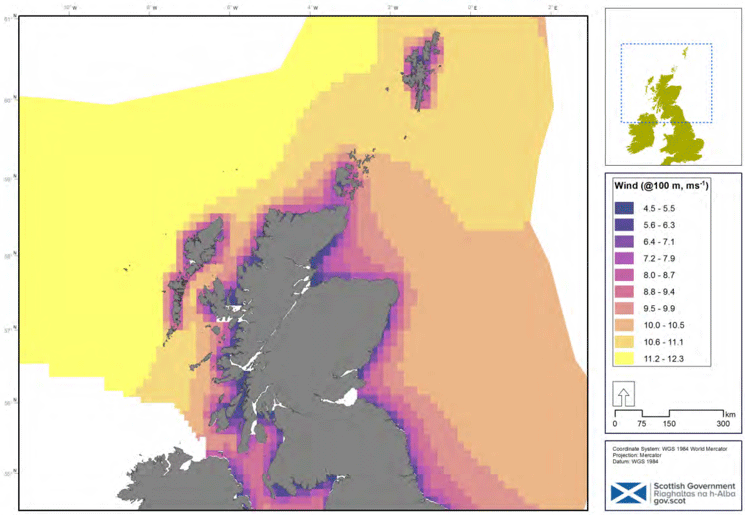
3.5.2 Grid connection
Offshore wind technologies often require an electrical grid connection to demonstrate the full commercial generation cycle. More distance from shore generally equates to more cost. In this scoping study two indicators of grid potential have been included, both based on distance: distance from electrical substations and distance from key cable landings.
Alternative uses for the electricity generated at sea may become commercially available and be integrated into the chain of supply. Should battery or an alternative storage technology mature sufficiently in the near future it may form part of the offshore wind supply chain.
These layers were generated using the Euclidean distance function in ArcGIS and the three classes used were based on the distance from the key cable landing or substation. Figure 6 shows the distance bandings from the application of this distance tool before the layer was reclassified into three classes. The distances applied to the three classes were 0-50 (low constraint), 50-100 (medium constraint) and more than 100 km (high constraint).
Figure 6: Distance bandings created from electrical substations. Substation spatial information has been taken from National grid. Important cable landings have also been included. The Key cable landings layer was created and classified in the same manner. © Crown copyright and database rights (2018) OS (100024655).
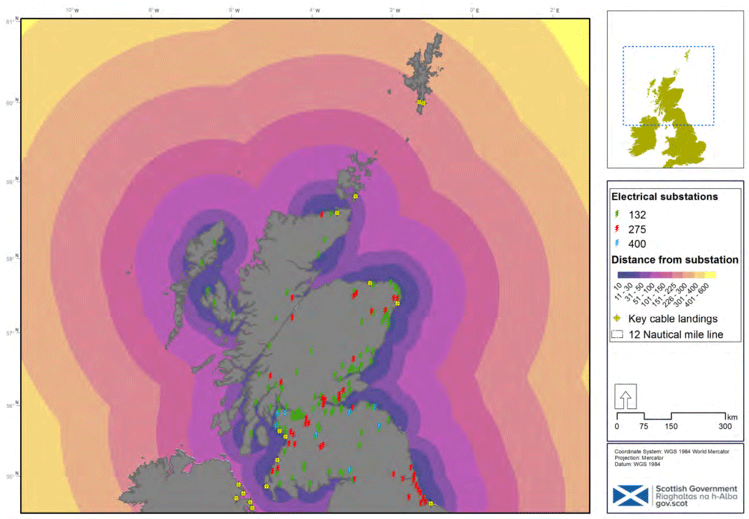
3.5.3 Depth
Offshore wind industry forecasts (Haslett, 2016) have expressed that from 50 m in depth the difference in cost becomes noticeable between fixed and floating foundations. In waters deeper than 50 m the versatility of floating foundations becomes a strong asset. Fixed foundations, mostly monopile type structures with a smaller percentage of jacket type structures, are a more technically developed approach and in waters between 30 and 50 m are the most mature foundation. The cost decrease in the energy generated by this technology has decreased quicker than forecasted in recent years (The Crown Estate, 2012). Based on this price reduction in the seabed fixed technologies some industry forecasts point towards a similar rapid decrease in floating wind technologies (Haslett, 2016) towards 2050.
Bathymetry can also be considered a broad scale distance from shore proxy as mostly the large areas of deeper water are further away from the coast. Figures 7 and 8 show the bathymetry as a continuous layer and subdivided by depth ranges to allow visualisation of the relative amount of area at 60 m, 60-100 m and over 100 m.
This layer was classified categorically using depths up to 0-200 as the least constraining class, depths of 200-700 and the medium and depths over 700 m were classed as highly constrained. The lower constraint depths of 0-200 cover the majority of the North Sea and west coast up till the western shelf edge. All current technologies can be accommodated within this depth range. Although the classified layer used in the multi-criteria analysis started at 0 m the shallowest any development is expected to be built at is 20 m.
Figure 7: Bathymetry of Scottish waters. © Crown copyright and database rights (2018) OS (100024655). © Crown Copyright, 2018. All rights reserved. License No. EK001-20140401.
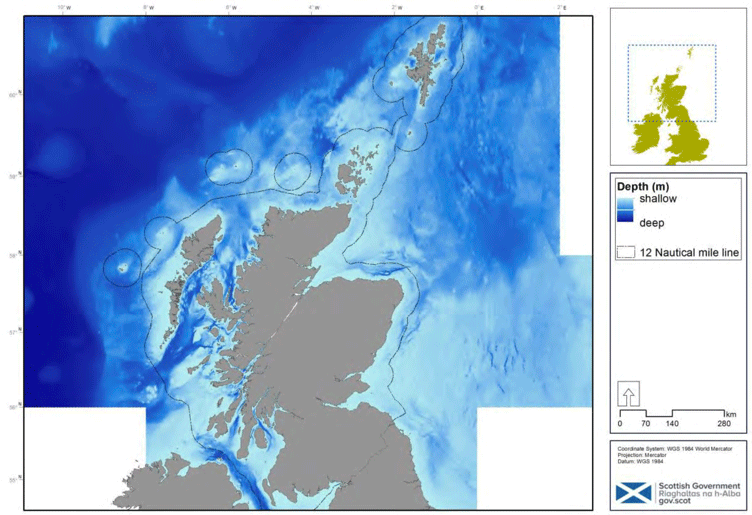
Figure 8: Bathymetry of Scottish waters separated into depth bandings to help visualisation of the relative area at each depth range. © Crown copyright and database rights (2018) OS (100024655). © Crown Copyright, 2018. All rights reserved. License No. EK001-20140401.
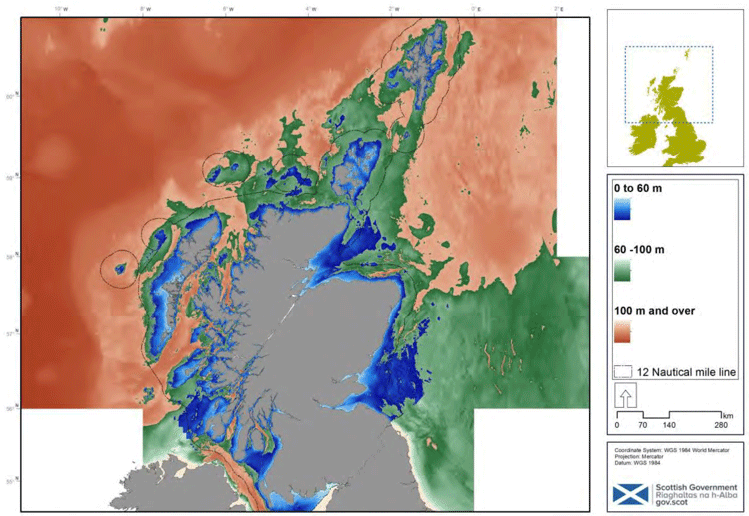
3.5.4 Sediment type
Floating wind technology seabed attachments can use a number of types. (Haslett, 2016). The anchoring methodology eventually chosen will depend on the sediment type and will likely require soft sediments deep enough for penetration to work effectively. Mud, sand or gravel substrates were considered appropriate, rocky sea beds were considered to be more constrained. The layer used, however, only provides information on the type of sediment and not on the depth of sediment at any location. The sediment depth would be a requirement to be investigated at specific locations once they have been chosen.
This layer was classified categorically. The four classifications were converted to two by amalgamating the muddy, gravelly and sandy substrates into one class as the lowest constraint and classifying rocky substrates as the highest constraint.
Figure 9: Sediment types on Scottish waters. Data from British Geological Survey. © Crown copyright and database rights (2018) OS (100024655). © Crown Copyright, 2018. All rights reserved. License No. EK001-20140401.
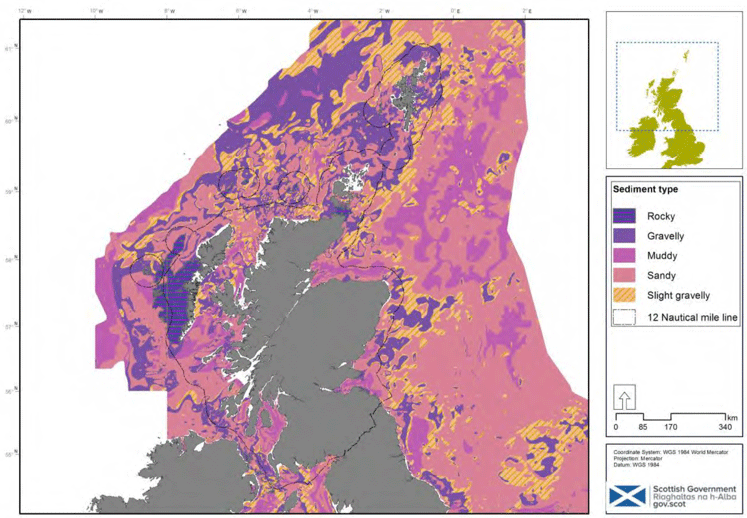
3.5.5 Nature protected areas
These are designated by the Scottish Government under European directives, or through national nature conservation legislation. Their constraint was considered on an individual basis. European designated sites were given a high constraint (3), national and regional designated sites were given a medium constraint level (2). Not yet fully designated protected areas such as draft offshore Special Protected Areas ( SPA) and the Marine Protected Areas ( MPA) areas of search have been included but have been given a medium constraint level (2) as they may not go to full designation but should be included in the analysis. For the multi-criteria analysis all nature designated areas were joined together to form one layer and this layer was given the highest possible weighting. Many of these designated areas overlap directly so to avoid counting any of them more than once all the layers were merged together to form one single spatial footprint.
Figure 10: All of the offshore and coastal nature protected designations that have been included into the multi-criteria analysis. © Crown copyright and database rights (2018) OS (100024655). © Crown copyright. All rights reserved. Joint Nature Conservation Committee Support Co 2018.
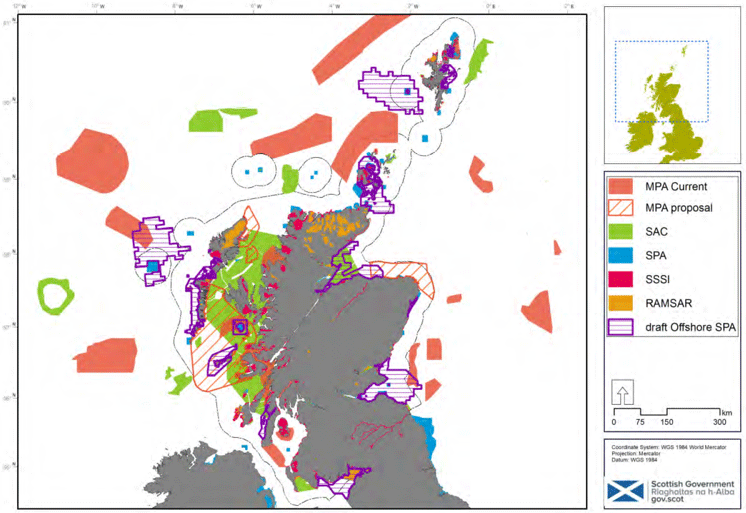
3.5.6 Fishing activity
There is a varied and flexible fishing industry working in Scotland. Boats of different sizes exploit different areas at different times of year. Some are more predictable than others as their quarry is specific to a particular type of substrate, for example scallops or trawled nephrops. Others, for example squid or herring, are more variable in the locations where the fishery is prosecuted.
With the advent of Automatic Information Systems ( AIS), foreign vessel activity can also be plotted, although it was not included in this study.
This is an important industry in Scotland from an economic and social point of view and it is essential to include its footprint into the spatial analysis. Fishing can be considered a heritage activity as well as an industry as its significance spreads through generations in more senses than the purely economic. It is important to assess both the areas that are currently fished and to investigate those that may be fished in the future as patterns do change and the fishing industry will adapt by returning to historically fished zones or discovering new ones.
The layer used for this scoping study included Vessel Monitoring System ( VMS) data as well as outputs from the Scotmap project. Since Scotmap did not cover the entirety of the Scottish inshore fleet, landings as reported by statistical square extent were incorporated into the layer to ensure as complete a representation as possible. This layer scales the VMS and the Scotmap output to the same economic value range so that all fisheries in Scotland can be looked at together on a monetary value basis.
The fishing layer was reclassified into three classes by applying the quantile classification and selecting three classes. The resulting low medium and high classes gave a suitable reflection of the range of values in this layer.
Figure 11: Fishing activity by monetary value including data from VMS and from Scotmap as well as supplementary landings information for the inshore fishing data. The data period mapped was 2007-2011. © Crown copyright and database rights (2018) OS (100024655).
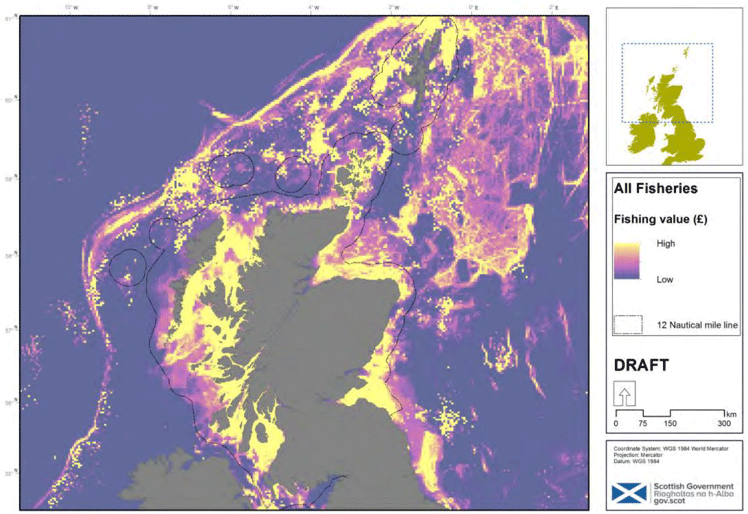
3.5.7 Sea and coast based leisure activities
The use of sea and coastal areas by the Scottish population has to be considered when developing any infrastructure in our waters. Spatial data can help to visualise preliminary areas of conflict and to help identify suitable locations that do not interfere with these important socio-cultural locations. The Scottish Marine Recreation and Tourism Survey ( LUC, 2016) has helped to answer questions on the locations where various coastal and sea-based activities happen. Results from the responses provided for this voluntary survey have been used to visualise the density, amount of users per unit area, of the activities recorded around the coast and inshore waters. The layer used to summarise all activities has been included in the constraint model.
Data sets under this theme can often be the hardest to categorise into measurable and comparable outputs as what they represent is often not as tangible or quantifiable as other layers. However, outputs from the Scottish Marine Recreation and Tourism Survey ( LUC, 2016) have allowed spatial data on human leisure interactions to be added to these analyses. This has improved greatly the description of leisure activities around the cost and has added a quantitative element to these maps. The previously used data were based on static points and gave no sense of relative amount of use. However, this data should not be considered exhaustive or unbiased.
Figure 12: Combined coast and sea-based activities density map taken from the Scottish Marine Recreation and Tourism Survey (2016). © Crown copyright and database rights (2018) OS (100024655).
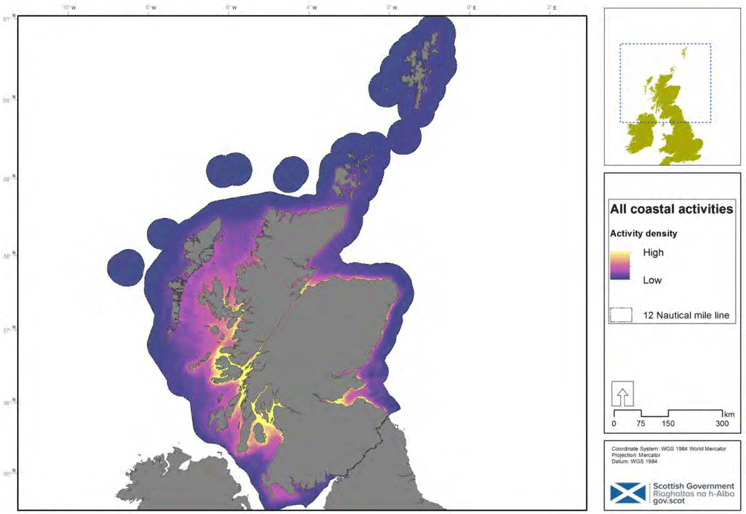
3.5.8 Military exercise areas
Information about military operations is kept confidential. However, the broad scale areas shown on the map below identify areas used for offshore military exercise purposes. Military operations are not constant in time or location, but for planning purposes they must be taken into account. Once more specific locations are identified, consultation with the Ministry of Defence ( MOD) will help to establish if any exercises undertaken in the chosen area are likely to be incompatible with offshore developments.
Areas where operations are undertaken at high altitudes were removed as these do not overlap with the footprint of offshore wind sites. This layer has been classified into two classes using the metadata provided by the MOD with this layer and based on the level of risk.
Figure 13: Military exercise areas. © Crown copyright and database rights (2018) OS (100024655). © Crown Copyright, 2018. All rights reserved. License No. EK001-20140401. Not to be used for Navigation.
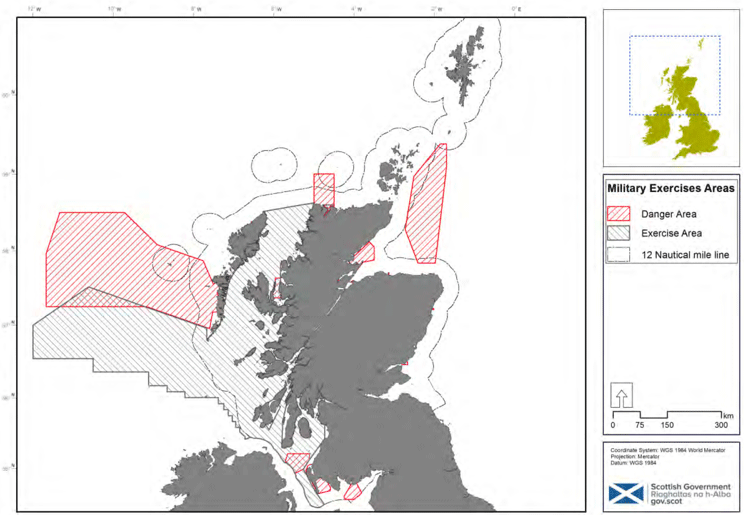
3.5.9 Shipping
Scotland has busy shipping lanes used by cargo vessels, oil tankers and, predominantly in the east coast, the support vessels for the oil and gas industry. Decoded and processed AIS data is available from online sources and has been used in this assessment. Figure 14 shows the density of all vessels for the first week of each month of 2015.
AIS data is available from sources like the Maritime and Coastguard Agency who can provide it to government organisations. Coastal based radar received AIS data from 2015 has been processed and made available online by ABPMer.
This layer was classified into three classes by using the quantile classification technique to investigate the distribution. The data values are highly skewed with less data in the higher density values, the quantile distribution exaggerated the spread to the higher values. The middle (medium) value was increased to 200 vessels per week as otherwise the shipping layer exaggerated the extent of high density shipping presence. At these custom breaks the three classes take in the main routes without spreading out too much in the highest class value.
Figure 14: Annual mean shipping density as calculated by ABPMer for the year 2015. © Crown copyright and database rights (2018) OS (100024655). © ABPMer copyright (2018) http://www.abpmer.net/downloads/default.asp?location=ArcGIS_Online&request=2015_AIS.
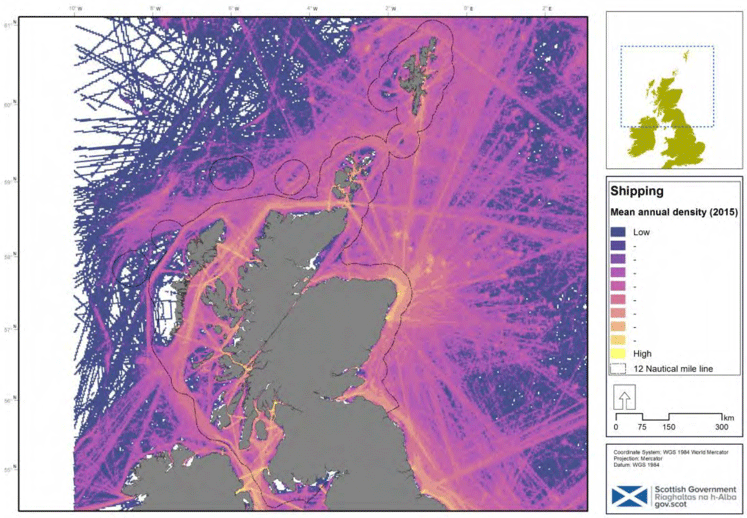
3.5.10 Aviation
The spatial extent of potential interference between offshore wind turbines and Civil Aviation Authority radar is represented using the National Air Traffic Services ( NATS) provided GIS layers. These give an indicative guide and identify areas where a developer should consult with NATS to investigate the importance of overlaps between any likely interference and the planned development. The probable interference layer up till 200 m height was chosen given that increasing wind turbine sizes are likely to reach this elevation. The data can be downloaded from the NATS self-assessment site ( NATS, 2018). These maps describe areas where the height of the turbines could present a potential interference hazard to primary surveillance radars operated or used by NATS En-Route. Helicopter routes were also provided by NATS as a map of helicopter main routes showing the Northern North Sea Offshore safety area. The lines of this map were digitized to convert the image to a usable GIS format.
Figure 15: Radar interference taken from the NATS self-assessment website and helicopter flight routes to oil and gas locations. © Crown copyright and database rights (2018) OS (100024655) © NATS copyright (2018) https://www.nats.aero/services/information/wind-farms/self-assessment-maps/.
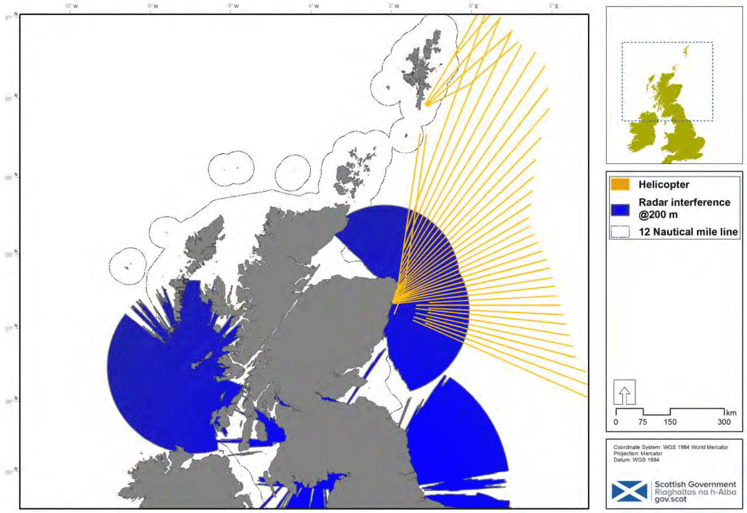
3.5.11 Seabirds and cetaceans
The construction process of offshore wind farms can generate a number of impacts which marine mammals may be sensitive to. Principally during the construction period as the percussive noise of some installation methods such as piling has been shown to affect marine mammals (Southall et al., 2007). For seabirds the potential collision, displacement and barrier effects can have an impact on seabird populations over the lifespan of the development. The layers used to represent constraint generated from seabirds, expressed as vulnerability to collision with offshore wind farms were created using a combination of data sources. The overall seabird density was taken from the European seabirds at sea survey data ( ESAS). Two seabird layers were generated, one for the breeding season and one for the overwintering seabirds. Initially these layers were created for the scoping study of 2011 and they show an overall density of all recorded species. Each of these species' distribution layers are then combined with a factor based on their vulnerability to wind energy based on the seabirds' physical characteristics. The creation of these vulnerability factors is documented in Furness et al. (2012).
The seabird vulnerability layers were classified into three classes by examining the distribution of the vulnerability values. The range of values for both the seabird layers were skewed highly over a huge range towards the lower values, so for both these layers it was considered appropriate to choose the class breaks based on a modified natural breaks classification. This provided a more balanced distribution between the three classes and did not overwhelm the inshore areas with higher constraint values than were warranted.
The cetacean layer used was created by combining surveyed densities of the most common cetacean species as collected into a series of data sets by Reid, Evans and Northridge (2003). This layer's value distribution was also skewed towards the lower values. A set of classes that did not overstate the high class and balanced out the mid and low classes was arrived at manually.
Figure 16: Vulnerability to collision of seabirds during the breeding season. © Crown copyright and database rights (2018) OS (100024655).
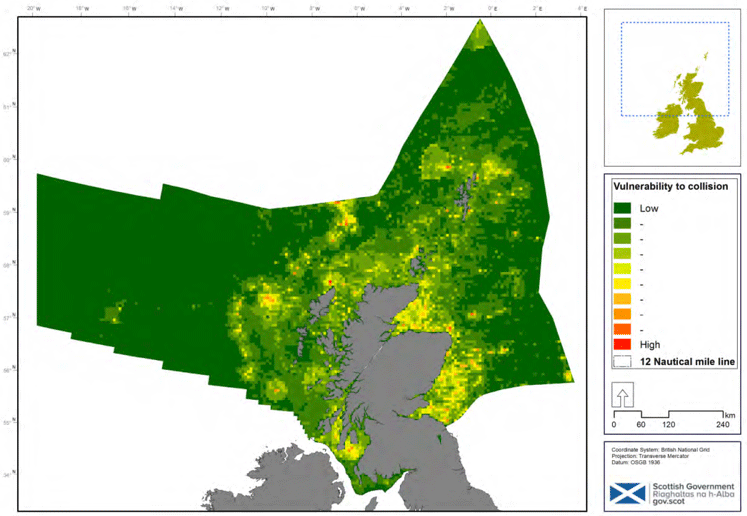
Figure 17: Vulnerability to collision of seabirds during the winter season. © Crown copyright and database rights (2018) OS (100024655).
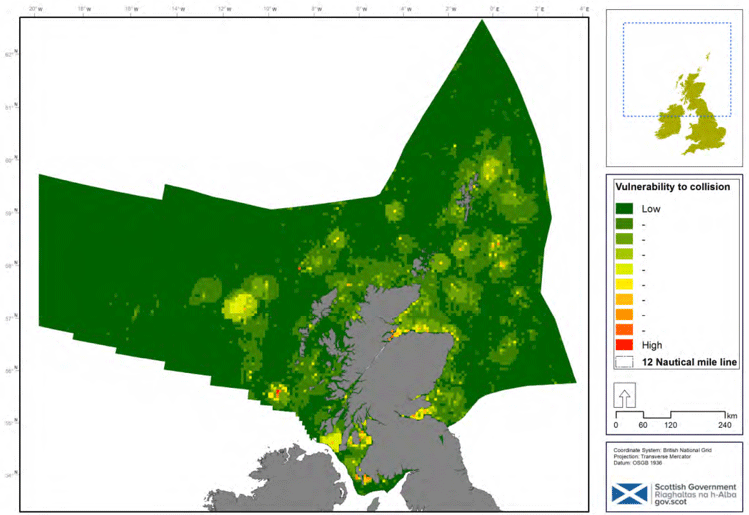
Figure 18: Overall cetacean density distribution created from individual cetacean distribution maps. © Crown copyright and database rights (2018) OS (100024655).
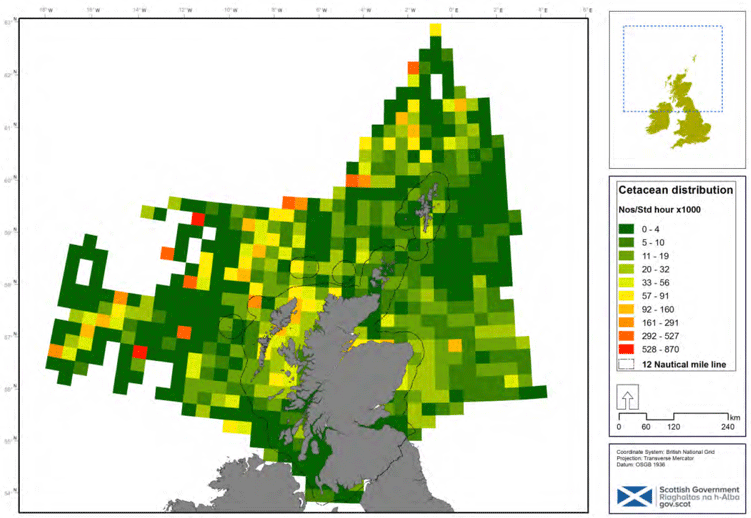
3.5.12 Fish life history layers
Offshore construction may have an adverse effect on sensitive stages of fish life history such as spawning times and early stages of life. It is important to include these aspects of fish biology into this process as construction on or near these sites may have effects on fish populations.
Spatial layers of information have been created to show the probability of aggregations of 0-group fish (fish in their first year of life). These have been combined to allow inclusion of one layer that accounts for this aspect.
The availability of up to date spawning information and its spatial representation varies between species. Some recent studies have generated probability outputs that show where cod and haddock spawning sites are likely to be found (Gonzalez-Irusta and Wright, 2015), (González-irusta and Wright, 2016). Other species will also have to be represented where no new information was available. Layers of the likely spawning footprint and overlap of 11 commercial species ( CEFAS, 1998) have been combined to show a cumulative footprint of known spawning grounds. This footprint and overlap is shown in Figure 19 before it was reclassified to three classes. This layer was classified into three classes by using an equal interval classification. The higher number of spatial overlaps was classified as higher constraint and the lowest in to the lowest constraint class.
The 0-group (first year of life) aggregation encounter probability layer, an update of the CEFAS (1998) nursery layers was a composite of the probability of encountering 0-group aggregations for 13 species (Aires, Gonzalez-Irusta and Watret, 2014). This layer was created by reclassifying each species' layer separately into a standard range of 0-9 then adding together these standardised layers. These layers were then classified into three classes distributed so as not to exaggerate or misrepresent the spatial extent of each class. The haddock spawning layer was classified in the same way.
The cod spawning layer had four categories that were converted into three by merging the two less recurring categories into one.
Figure 19: Extent and overlap amount of spawning areas for 11 species listed in ( CEFAS, 1998) (cod and haddock excluded as their spawning locations have been updated). © Crown copyright and database rights (2018) OS (100024655).
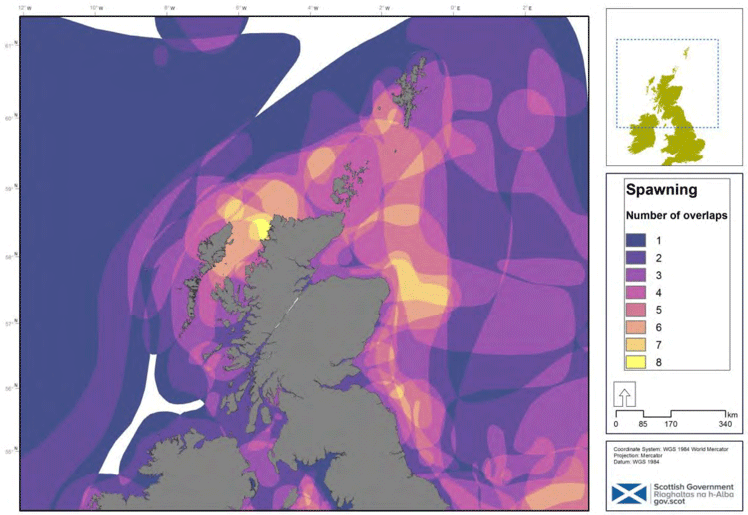
Figure 20: Spawning area preferences of cod from (Gonzalez-Irusta and Wright, 2015). This modelling was restricted to the east and north coasts of Scotland. © Crown copyright and database rights (2018) OS (100024655).
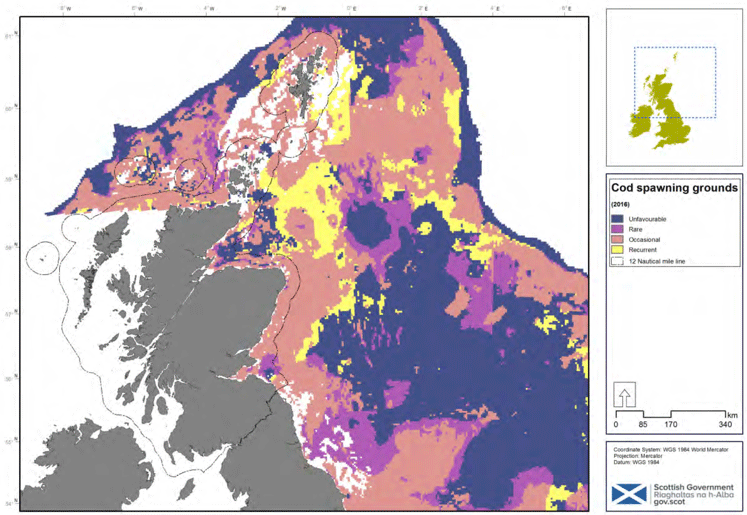
Figure 21: Probability of encountering spawning haddock from (González-irusta and Wright, 2016). © Crown copyright and database rights (2018) OS (100024655).
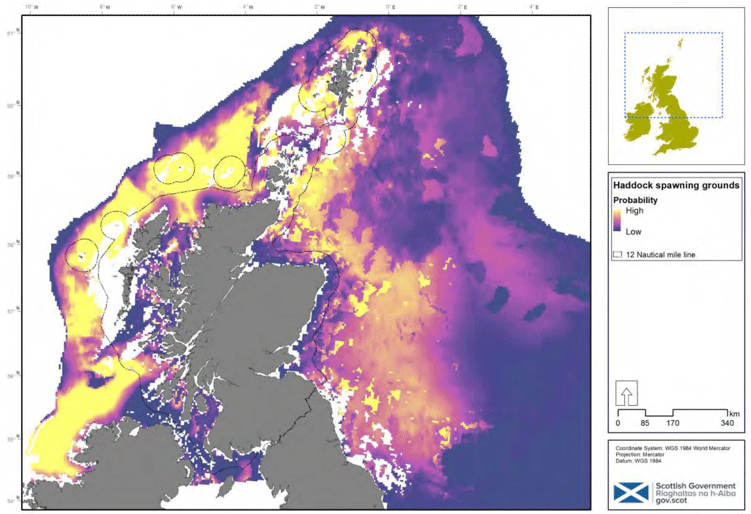
Figure 22: Probability of encountering aggregations of fish in the first year of life from Aires et al. (2014). © Crown copyright and database rights (2018) OS (100024655).
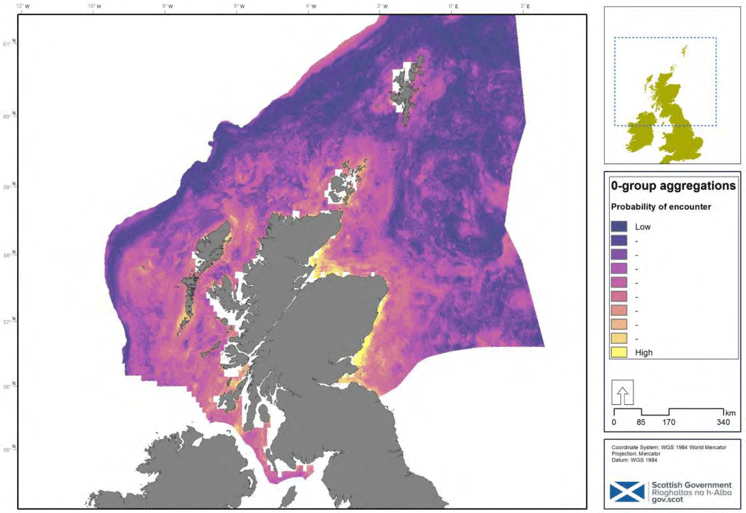
Contact
There is a problem
Thanks for your feedback